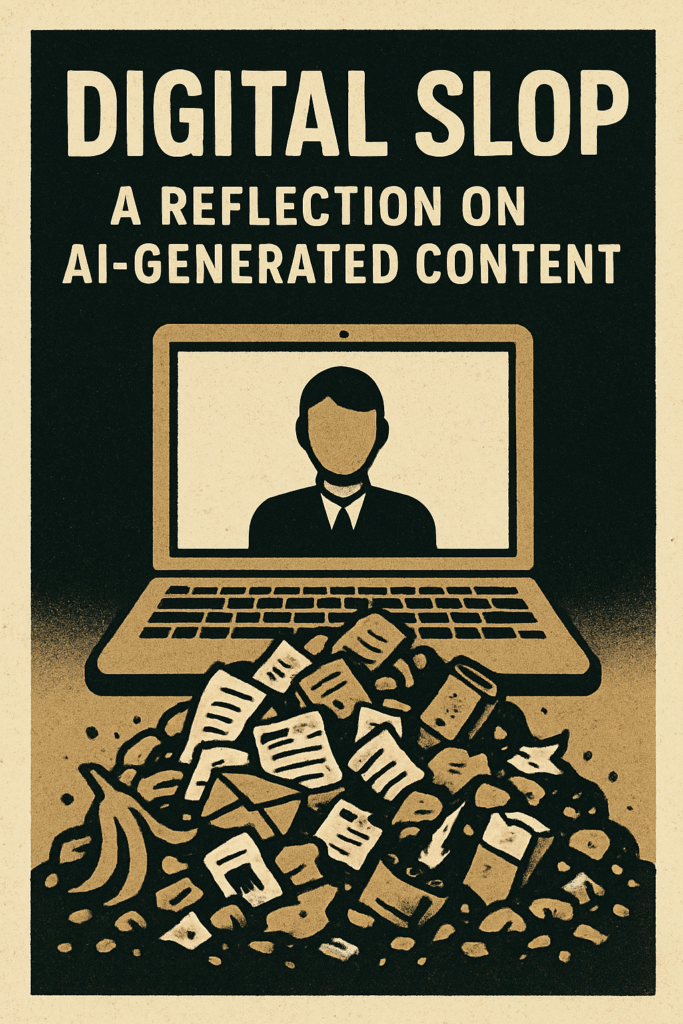The term AI slop, coined in the 2020s, refers to low-quality content produced on a massive scale by generative artificial intelligence systems. With a derogatory tone reminiscent of spam, the concept points to tensions surrounding the transformation of informational circuits under automated logic.
AI slop is characterized by a prioritization of speed and volume over intellectual substance. It consists of texts and images generated based on predictable patterns, presented in generic styles, easily processed by both human users and algorithms. This type of material bypasses the need for more complex aesthetic or cognitive mediation, reducing production to an exercise in probabilistic replication. The result is a constant stream of indistinct content, designed to fill gaps in recommendation systems and search engine indexes.
Early discussions around the term appeared on forums such as 4chan, Hacker News, and YouTube, especially after the release of AI image generators in 2022. The expression gained broader visibility in May 2024, when British programmer Simon Willison used it in critiques of Google’s Gemini model. At that point, concerns intensified regarding the decline in quality of search results and the growing saturation of digital environments with automated material.
The widespread use of AI by content creators—particularly in contexts marked by economic precariousness—highlights the effects of current monetization dynamics. Platform reward systems encourage continuous production regardless of consistency, as long as engagement is sufficient to activate advertising circuits. The appearance of authenticity, achieved through linguistic and visual simulation, becomes enough to trigger attention and consumption mechanisms.
On the Dynamics of Digital Slop
The spread of AI slop destabilizes informational ecosystems by making reliable sources more difficult to access. The overwhelming volume of automated publications interferes with indexing mechanisms, weakens relevance criteria, and reshapes what is perceived as accessible or trustworthy. Beyond sheer quantity, there is also the circulation of potentially manipulative content, in which persuasive language strategies are employed for disinformation purposes.
The term slopaganda has been proposed to describe a hybrid form combining propaganda and digital slop, distinguished by its automated reach and its ability to adapt to specific audiences. Message individualization, combined with the speed of distribution, enhances the effects of strategies based on cognitive biases such as repetition or artificial familiarity. The constant repetition of false statements, for instance, tends to increase their subjective acceptability, even in the absence of factual verification.
Such operations interfere with long-term memory organization and weaken critical filters. The repeated use of alarming or emotionally charged elements encourages automatic responses, activating the negativity bias, through which negative content is more easily retained and incorporated into prior knowledge. In this context, the automated production of sensationalist materials functions as a disruption of attention and a challenge to interpretive capacity.
The uninterrupted circulation of this content reshapes the experience of social networks, increasingly populated by bots and automated accounts. Genuine human interaction becomes less frequent, replaced by visibility dynamics governed by machines. As the boundary between human and automated production erodes, the ability to assign responsibility diminishes, complicating efforts to build informed consensus.
Modes of Analysis and Systemic Considerations
The presence of AI slop reflects a structural shift in the conditions of information production and circulation. The use of automated moderation systems, though necessary, does not address the underlying issue, which lies in the incentive structures and the imbalance of power between technological agents and ordinary users. Algorithms that prioritize immediate engagement tend to favor AI-generated content, as it more readily meets expectations of volume and predictability.
Experiments with educational games simulating disinformation tactics have opened up useful avenues for understanding the underlying mechanisms, especially when players take on the role of disinformation producers. While such approaches do not address the problem at scale, they offer insight into the rhetorical techniques at play.
AI content detection tools have seen some development, though technical and political challenges remain. The history of spam control suggests that containing massive flows of automated content requires intersectoral collaboration, along with clear criteria regarding what should be considered acceptable. In the case of AI slop, these criteria are still under negotiation.
Inequalities in access to tools and the asymmetry in profit distribution aggravate the situation. While large platforms monetize the traffic generated by slop, ordinary users navigate saturated environments with weakened references. Discussions around regulation, therefore, must address the economic foundations of current platforms, not only the technical aspects of content control.
Final Remarks
AI slop is not merely a byproduct of technological development but the result of specific decisions about what circulates, how, and for what purposes. Its growing presence reshapes reading practices, search habits, and the parameters by which knowledge is validated. Analyzing this phenomenon contributes to a broader understanding of the current stage of digital culture, in which the sheer volume of data surpasses interpretive capacity, and the appearance of information becomes sufficient to occupy the space formerly reserved for critical elaboration.

